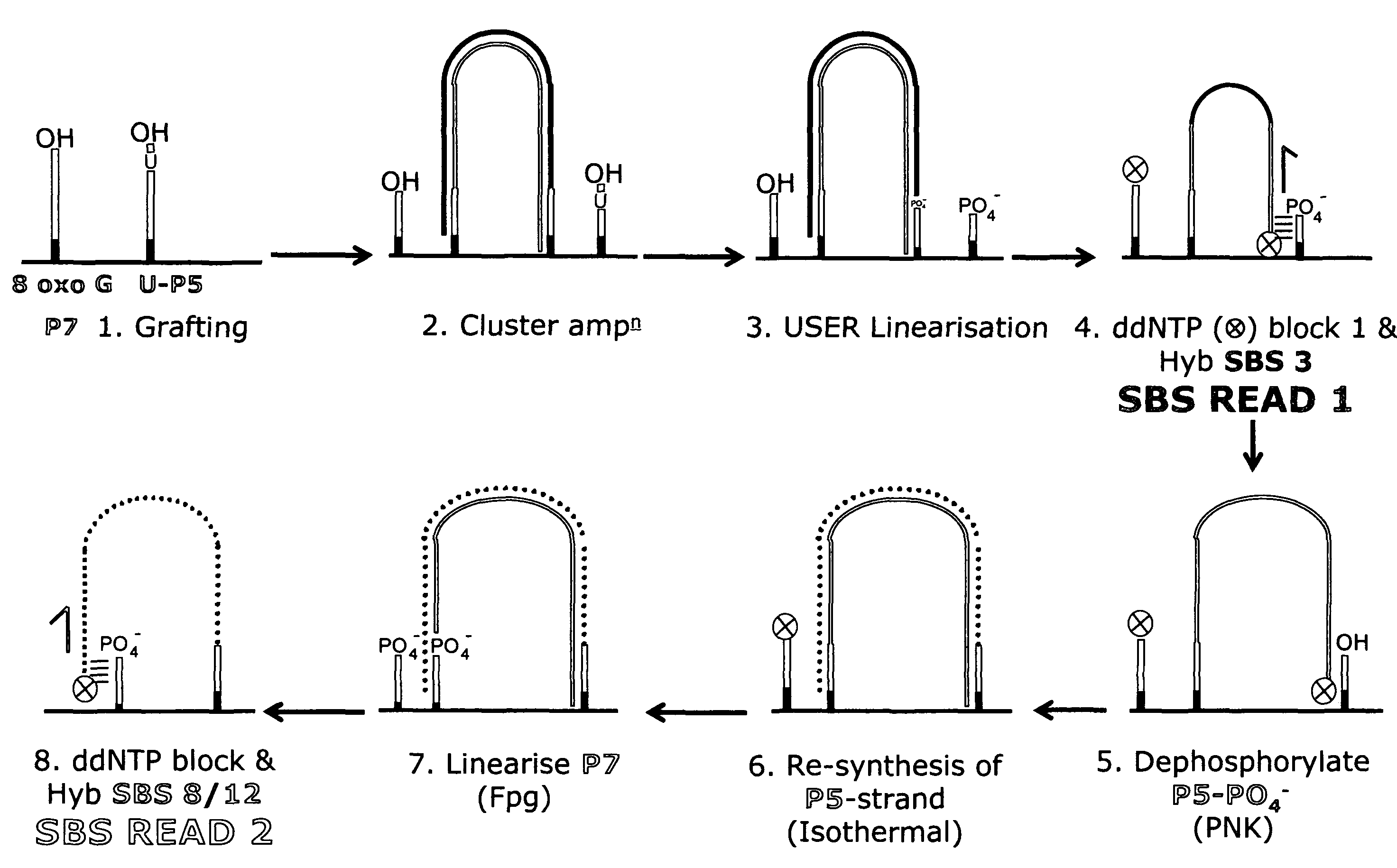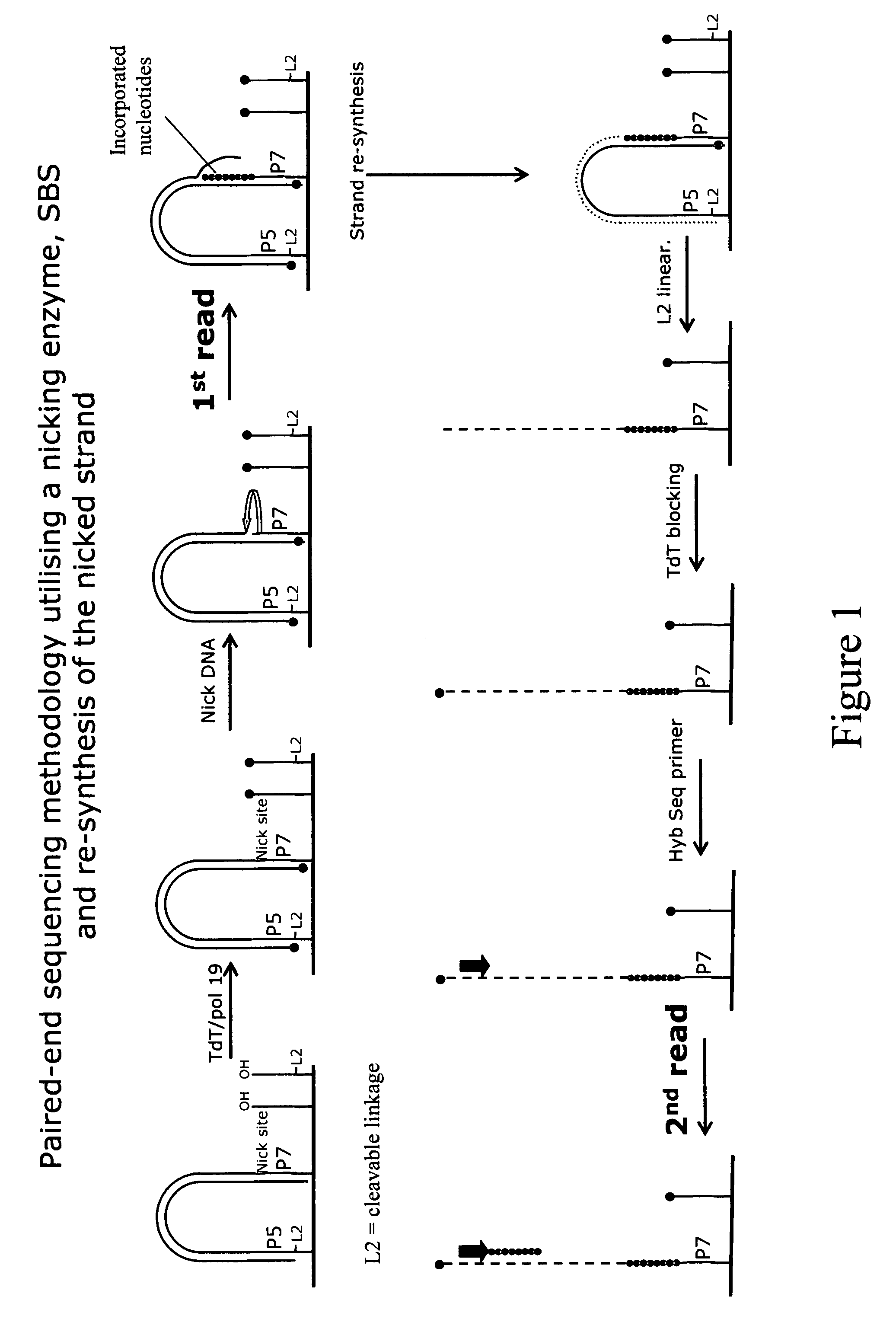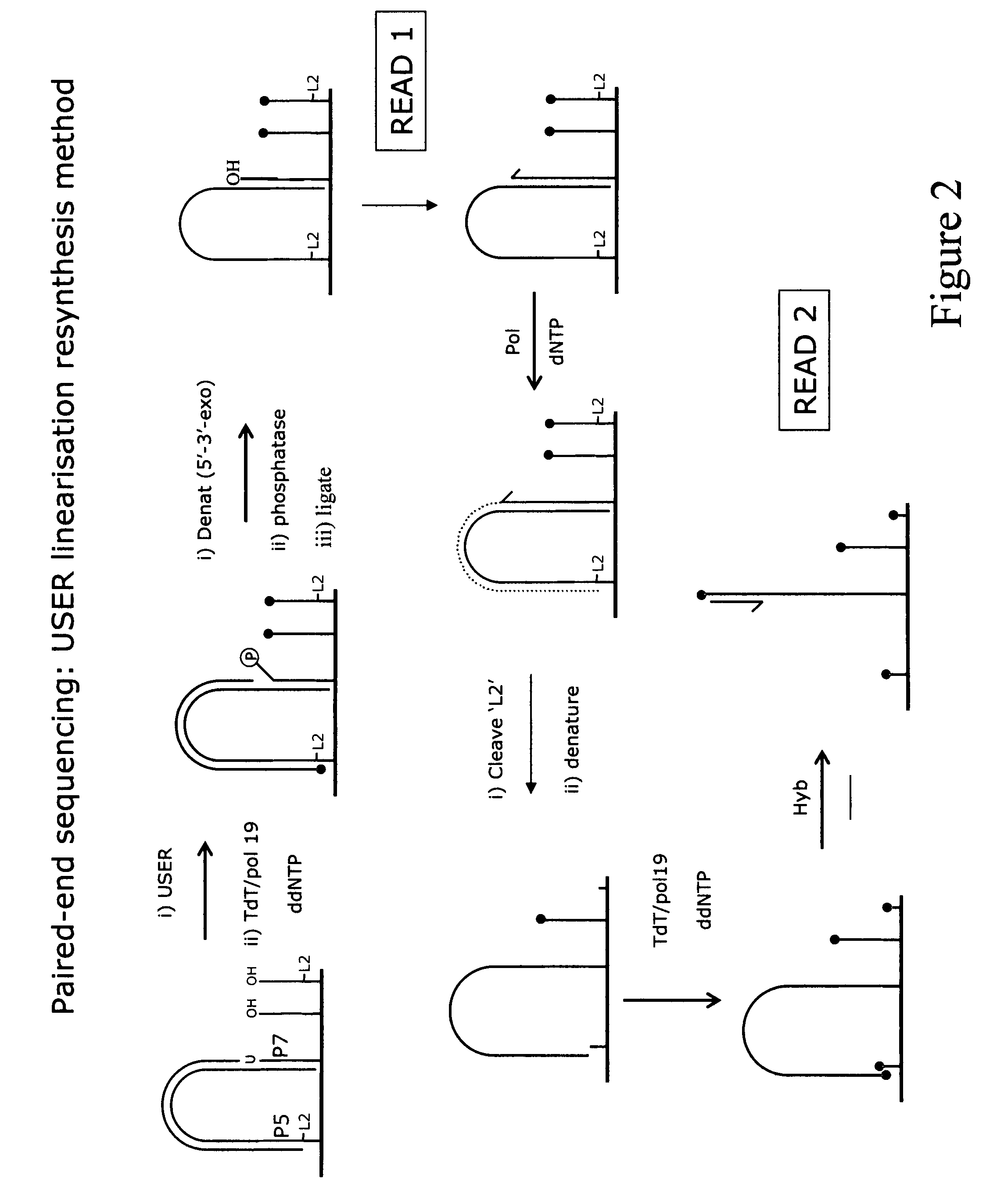Method for pair-wise sequencing a plurity of target polynucleotides
a target polynucleotide and pairwise sequencing technology, applied in the field of pairwise sequencing of double-stranded polynucleotide templates, can solve the problems of limited sequence data that can be reliably obtained with the use of sequencing-by-synthesis techniques, particularly nucleotides, and the difficulty of using array-based sequencing techniques, so as to improve the data quality of a sequencing reaction
- Summary
- Abstract
- Description
- Claims
- Application Information
AI Technical Summary
Benefits of technology
Problems solved by technology
Method used
Image
Examples
example 1
Cluster Preparation Using the Detailed Invention
Acrylamide Coating of Glass Chips
[0162]The solid supports used are typically 8-channel glass chips such as those provided by Silex Microsystems (Sweden). However, the experimental conditions and procedures are readily applicable to other solid supports.
[0163]Chips were washed as follows: neat Decon for 30 min, milliQ H2O for 30 min, NaOH 1N for 15 min, milliQ H2O for 30 min, HCl 0.1N for 15 min, milliQ H2O for 30 min.
Polymer Solution Preparation:
For 10 ml of 2% polymerisation mix.
[0164]10 ml of 2% solution of acrylamide in milliQ H2O[0165]165 μl of a 100 mg / ml N-(5-bromoacetamidylpentyl)acrylamide (BRAPA) solution in DMF (23.5 mg in 235 μl DMF)[0166]11.5 μl of TEMED[0167]100 μl of a 50 mg / ml solution of potassium persulfate in milliQ H2O (20 mg in 400 μl H2O)
[0168]The 10 ml solution of acrylamide was first degassed with argon for 15 min. The solutions of BRAPA, TEMED and potassium persulfate were successively added to the acrylamide so...
example 2
Synthesis of N-(5-bromoacetamidylpentyl)acrylamide (BRAPA) (1)
[0169]
N-Boc-1,5-diaminopentane toluene sulfonic acid was obtained from Novabiochem. The bromoacetyl chloride and acryloyl chloride were obtained from Fluka. All other reagents were Aldrich products.
[0170]
[0171]To a stirred suspension of N-Boc-1,5-diaminopentane toluene sulfonic acid (5.2 g, 13.88 mmol) and triethylamine (4.83 ml, 2.5 eq) in THF (120 ml) at 0° C. was added acryloyl chloride (1.13 ml, 1 eq) through a pressure equalized dropping funnel over a one hour period. The reaction mixture was then stirred at room temperature and the progress of the reaction checked by TLC (petroleum ether:ethyl acetate 1:1). After two hours, the salts formed during the reaction were filtered off and the filtrate evaporated to dryness. The residue was purified by flash chromatography (neat petroleum ether followed by a gradient of ethyl acetate up to 60%) to yield 2.56 g (9.98 mmol, 71%) of product 2 as a beige solid. 1H NMR (400 MHz,...
example 3
Grafting Primers onto Surface of SFA Coated Chip
[0175]An SFA coated chip is placed onto a modified MJ-Research thermocycler and attached to a peristaltic pump. Grafting mix consisting of 0.5 μM of a forward primer and 0.5 μM of a reverse primer in 10 mM phosphate buffer (pH 7.0) is pumped into the channels of the chip at a flow rate of 60 μl / min for 75 s at 20° C. The thermocycler is then heated to 51.6° C., and the chip is incubated at this temperature for 1 hour. During this time, the grafting mix undergoes 18 cycles of pumping: grafting mix is pumped in at 15 μl / min for 20 s, then the solution is pumped back and forth (5 s forward at 15 μl / min, then 5 s backward at 15 μl / min) for 180 s. After 18 cycles of pumping, the chip is washed by pumping in 5×SSC / 5 mM EDTA at 15 μl / min for 300 s at 51.6° C. The thermocycler is then cooled to 20° C.
[0176]The primers are typically 5′-phosphorothioate oligonucleotides incorporating any specific sequences or modifications required for cleavage....
PUM
| Property | Measurement | Unit |
|---|---|---|
| temperature | aaaaa | aaaaa |
| flow rate | aaaaa | aaaaa |
| pH | aaaaa | aaaaa |
Abstract
Description
Claims
Application Information
 Login to View More
Login to View More - R&D
- Intellectual Property
- Life Sciences
- Materials
- Tech Scout
- Unparalleled Data Quality
- Higher Quality Content
- 60% Fewer Hallucinations
Browse by: Latest US Patents, China's latest patents, Technical Efficacy Thesaurus, Application Domain, Technology Topic, Popular Technical Reports.
© 2025 PatSnap. All rights reserved.Legal|Privacy policy|Modern Slavery Act Transparency Statement|Sitemap|About US| Contact US: help@patsnap.com



